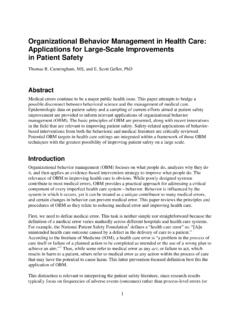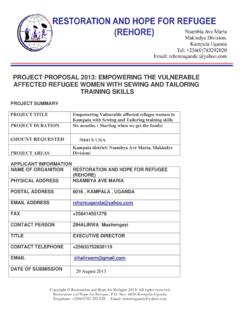Transcription of Handbook on strategies to reduce overcrowding in prisons
1 Handbook on strategies to reduce overcrowding in prisons CRIMINAL JUSTICE Handbook SERIES. In cooperation with the International Committee of the Red Cross Front cover photograph (centre): CICR/VON TOGGENBURG, Christoph, 2010. UNITED NATIONS OFFICE ON DRUGS AND CRIME. Vienna Handbook ON strategies TO reduce . overcrowding IN prisons . CRIMINAL JUSTICE Handbook SERIES. UNITED NATIONS. New York, 2013. United Nations, October 2013. All rights reserved, worldwide. The designations employed and the presentation of material in this publication do not imply the expression of any opinion whatsoever on the part of the Secretariat of the United Nations concerning the legal status of any country, territory, city or area, or of its authorities, or concerning the delimitation of its frontiers or boundaries. Publishing production: English, Publishing and Library Section, United Nations Office at Vienna. Foreword by the International Committee of the Red Cross (ICRC).
2 The work in favour of detainees has been a central feature of the ICRC throughout the 150 years of its existence. The first activities on behalf of prisoners were carried out as early as 1870 and the organization is well known for its work of visiting people detained in relation to armed conflicts, for which it has a specific monitoring mandate under international humanitarian law. It also acts on behalf of people deprived of their liberty in other contexts characterized by violence, social tension and unrest. In each context, the ICRC's priority is to ensure that detainees are treated humanely and with respect for their dignity, regardless of the reason for their detention. It works to reunite families and to ensure respect for due process. In 2011 the ICRC undertook detention-related activities in some 90 countries. In the same year, ICRC staff members conducted over 5,000 visits to more than 1,800 places of detention all over the world and were therefore in daily contact with thousands of detainees.
3 In very diverse environments and over many years, the ICRC has witnessed first- hand the consequences of overcrowding on detainees and on the authorities. Indeed, overcrowding is an increasingly widespread problem in a number of countries and places of detention. In itself, it is a very serious humanitarian concern, as it auto- matically generates substandard and often inhumane conditions of detention. Tens of thousands of people are forced to live for extended periods in congested accom- modation, with insufficient space to move, sit or sleep. This seriously compromises the ability of the administration to fulfil detainees' basic needs in terms of living conditions, medical care, legal aid and family visits. Being squeezed into cramped living quarters, often in appalling hygiene conditions and with no privacy, makes the experience of being deprived of freedom already stressful in normal circumstances . exponentially worse.
4 It erodes human dignity and undermines detainees' physical and mental health, as well as their reintegration prospects. In addition to putting excessive strain on infrastructures, it heightens the potential for tensions and conflicts among detainees and with staff. It quickly leads to difficulties in maintaining good order within the prison, resulting in potentially severe consequences in terms of safety for the detainees, as well as in terms of supervision and security. While the consequences are particularly grave for the men, women and children deprived of their liberty, they also affect the frontline staff whose job it is to protect and meet the needs of the detainees. Overwhelmed by excessive numbers and directly exposed to the frustration of the detainees without the resources needed to guarantee security or access to the most basic services, detention staff work in difficult condi- tions and are exposed to constant pressure and risk.
5 ICRC knows from experience that situations of overcrowding , once established, trig- ger a downward spiral which has a negative impact on the entire criminal justice system as a result of increasing congestion, staff demotivation and the development of parallel coping mechanisms or corruption. overcrowding is not an inevitability. Even if it is widespread and long-lasting, it should never become commonplace. From a humanitarian point of view, it is vital iii to address the issue of overcrowding in places of detention. This is a difficult and challenging undertaking, as overcrowding has multiple and cumulative causes, largely external to the prison system itself. It therefore cannot be addressed only at the level of prisons but requires a holistic and coordinated response from a broad range of authorities, including at the policy level and in society at large. The ICRC has observed over the years the difficulties experienced by many states in their efforts to improve the complex interactions between different actors, such as the legislature, judiciary, police, prosecutors, court administrations and oversight bodies, which are essential if the cycle of overcrowding is to be broken.
6 Questioning criminal policies, embarking on legislative or procedural changes and altering long- standing judicial practices are anything but straightforward matters. Considerable sensitivity is also called for when confronting commonly held perceptions or investing in diversion from detention while reassuring the public that measures are being taken to fight crime. Despite the plethora of information about prison overcrowding , the ICRC recognizes the need for holistic and practical guidance on how to avoid the phenomenon, to address it where it already exists and to alleviate its humanitarian consequences. That is the aim of this Handbook . It brings together the various causes and conse- quences of overcrowding and emphasizes the wide range of strategies that may be applicable across the prison system itself and across broader criminal justice and governance systems, depending on the particulars of a given situation. It illustrates the various strategies with cases drawn from operational experience and examples of practical measures which have achieved effective results and could be a source of inspiration for other countries.
7 The Handbook has been designed to appeal to a broad readership ranging from policymakers to practitioners. The intention is to promote a common understanding of the different interests, concerns and perspectives with regard to overcrowding , to advance the establishment of common conceptual frameworks and, as a result, to pave the way for coherent and applicable strategies that are designed to address overcrowding in a comprehensive manner. In the ICRC's experience, small but coordinated steps by a range of actors can make a real difference to the resolution of complex problems. For all those reasons the ICRC is pleased to have contributed to the publication of this Handbook , in partnership with UNODC. We believe that our different perspec- tives have strengthened and enriched its content. In the spirit of cooperation that has characterized its development, we recommend it not only to all ICRC teams in the field, but also to all those whose decisions can have an impact on overcrowding in prisons and thus ensure that detainees may live in decent and safe conditions, receiving treatment that is respectful of their dignity.
8 The ICRC looks forward to working alongside all those who are inspired by this Handbook to take steps, large and small, that can lead to sustainable solutions. Geneva, January 2013. Yves Daccord ICRC Director-General iv Acknowledgements This Handbook has been developed by the United Nations Office on Drugs and Crime (UNODC) in cooperation with the International Committee of the Red Cross (ICRC) and was written by Tomris Atabay, consultant on penal reform issues. The Handbook was reviewed at an expert group meeting held in Vienna on 14 15 November 2011. UNODC and ICRC wish to acknowledge with appreciation the contributions received from the following experts who participated in that meeting: Charles Robert Allen, Elias Carranza, Elinor Chemonges, Vivienne Chin, Yvon Dandurand, Louise Ehlers, Aubrey Fox, Andrea Huber, Richard Kuuire, Tapio Lappi-Sep l , Maira Rocha Machado, Martin Schonteich and Peter Severin. Further valuable comments and feedback were provided by UNODC experts Collie Brown, Carla Ciavarella, Celso Coracini, Gilberto Gerra, Fabienne Hariga, Valerie Lebaux, Alexandra Martins, Philipp Meissner, Maria-Noel Rodriguez, Renee Sabbagh, Elisabeth Saenz, Miri Sharon and Vera Tkachenko.
9 Also contributing throughout the development of the Handbook were Catherine Deman, Isabel Hight, Mary Murphy and Abigail Sloan (ICRC), as well as Piera Barzan , (UNODC). v Contents Page Foreword by the International Committee of the Red Cross (ICRC) .. iii Acknowledgements .. v Acronyms .. x INTRODUCTION.. 1. PART I. BACKGROUND .. 7. CHAPTER A PRISON overcrowding WORLDWIDE.. 7. 1. Overview.. 7. 2. The impact of overcrowding in prisons .. 11. 3. Broader consequences of excessive imprisonment.. 14. CHAPTER B CAUSES OF overcrowding IN prisons .. 19. 1. Imprisonment rates and crime trends.. 19. 2. Underlying causes: socio-economic and political factors.. 20. 3. Obstacles and delays in accessing justice .. 21. 4. Excessive pre-trial detention .. 22. 5. Punitive criminal justice policies.. 25. 6. Drug control policies .. 29. 7. The inappropriate use of imprisonment .. 30. 8. Inadequate use of alternatives to imprisonment .. 31. 9. Inefficient measures to promote social reintegration.
10 32. 10. Breaches of early conditional release and probation orders .. 33. 11. Crisis overcrowding .. 33. 12. Inadequate prison infrastructure and capacity .. 34. PART II. strategies TO reduce overcrowding IN prisons .. 39. CHAPTER A Developing comprehensive, evidence based strategies and gaining public support.. 39. 1. Fair social policies and crime prevention .. 39. 2. Political will and comprehensive criminal justice reform strategies .. 40. 3. Evidence-based policies responding to individual country needs .. 41. 4. Gaining public support .. 41. vii Page CHAPTER B REDUCING THE SCOPE OF IMPRISONMENT AND. DEVELOPING FAIR SENTENCING POLICIES .. 44. 1. Decriminalization and depenalization .. 45. 2. Imprisonment of children as a measure of last resort .. 47. 3. Removing mandatory minimum sentencing provisions .. 48. 4. Restricting the use of life sentences .. 49. 5. Rationalizing other sentences .. 51. 6. Introducing alternatives to imprisonment.
















